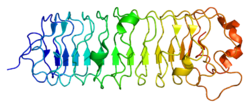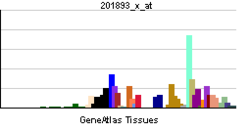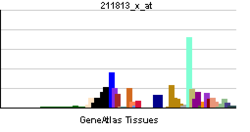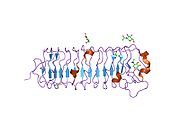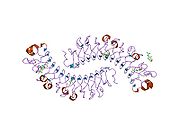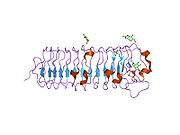- Decorin
-
Decorin is a proteoglycan on average 90 - 140 kilodaltons (kD) in size.
It belongs to the small leucine-rich proteoglycan (SLRP) family and consists of a protein core containing leucine repeats with a glycosaminoglycan (GAG) chain consisting of either chondroitin sulfate (CS) or dermatan sulfate (DS).
Decorin is a small cellular or pericellular matrix proteoglycan and is closely related in structure to biglycan protein. Decorin and biglycan are thought to be the result of a gene duplication. This protein is a component of connective tissue, binds to type I collagen fibrils, and plays a role in matrix assembly.[1]
Contents
Naming
Decorin's name is a derivative of both the fact that it "decorates" collagen, and that it interacts with the "d" and "e" bands.
Function
Decorin appears to influence fibrillogenesis, and also interacts with fibronectin, thrombospondin, the complement component C1q, epidermal growth factor receptor (EGFR) and transforming growth factor-beta (TGF-beta).
In some publications, decorin has been shown to enhance the bioactivity of TGF-beta 1, in other publications, TGF-beta 1's bioactivity has been shown to be inhibited. Because of this, it is believed the primary function of decorin lies in certain aspects of regulation during the cell cycle.
Infusion of decorin into experimental rodent spinal cord injuries has been shown to suppress scar formation and promote axon growth.
Decorin has been shown to have anti-tumorigenic properties in an experimental murine tumor model and is capable of suppressing the growth of various tumor cell lines. There are multiple alternatively spliced transcript variants known for the decorin gene. Mutations in the decorin gene are associated with congenital stromal corneal dystrophy.[1]
Interactions
Decorin has been shown to interact with Epidermal growth factor receptor[2][3] and TGF beta 1.[4][5][6]
References
- ^ a b "Entrez Gene: DCN decorin". http://www.ncbi.nlm.nih.gov/sites/entrez?Db=gene&Cmd=ShowDetailView&TermToSearch=1634.
- ^ Santra, Manoranjan; Reed Charles C, Iozzo Renato V (Sep. 2002). "Decorin binds to a narrow region of the epidermal growth factor (EGF) receptor, partially overlapping but distinct from the EGF-binding epitope". J. Biol. Chem. (United States) 277 (38): 35671–81. doi:10.1074/jbc.M205317200. ISSN 0021-9258. PMID 12105206.
- ^ Iozzo, R V; Moscatello D K, McQuillan D J, Eichstetter I (Feb. 1999). "Decorin is a biological ligand for the epidermal growth factor receptor". J. Biol. Chem. (UNITED STATES) 274 (8): 4489–92. doi:10.1074/jbc.274.8.4489. ISSN 0021-9258. PMID 9988678.
- ^ Hildebrand, A; Romarís M, Rasmussen L M, Heinegård D, Twardzik D R, Border W A, Ruoslahti E (Sep. 1994). "Interaction of the small interstitial proteoglycans biglycan, decorin and fibromodulin with transforming growth factor beta". Biochem. J. (ENGLAND) 302 ( Pt 2) (Pt 2): 527–34. ISSN 0264-6021. PMC 1137259. PMID 8093006. http://www.pubmedcentral.nih.gov/articlerender.fcgi?tool=pmcentrez&artid=1137259.
- ^ Schönherr, E; Broszat M, Brandan E, Bruckner P, Kresse H (Jul. 1998). "Decorin core protein fragment Leu155-Val260 interacts with TGF-beta but does not compete for decorin binding to type I collagen". Arch. Biochem. Biophys. (UNITED STATES) 355 (2): 241–8. doi:10.1006/abbi.1998.0720. ISSN 0003-9861. PMID 9675033.
- ^ Takeuchi, Y; Kodama Y, Matsumoto T (Dec. 1994). "Bone matrix decorin binds transforming growth factor-beta and enhances its bioactivity". J. Biol. Chem. (UNITED STATES) 269 (51): 32634–8. ISSN 0021-9258. PMID 7798269.
Further reading
- Ständer M, Naumann U, Wick W, Weller M (1999). "Transforming growth factor-beta and p-21: multiple molecular targets of decorin-mediated suppression of neoplastic growth". Cell Tissue Res. 296 (2): 221–7. doi:10.1007/s004410051283. PMID 10382266.
- Fujisawa R (2002). "[Recent advances in research on bone matrix proteins]". Nippon Rinsho 60 Suppl 3: 72–8. PMID 11979972.
- Krumdieck R, Höök M, Rosenberg LC, Volanakis JE (1992). "The proteoglycan decorin binds C1q and inhibits the activity of the C1 complex". J. Immunol. 149 (11): 3695–701. PMID 1431141.
- Winnemöller M, Schön P, Vischer P, Kresse H (1993). "Interactions between thrombospondin and the small proteoglycan decorin: interference with cell attachment". Eur. J. Cell Biol. 59 (1): 47–55. PMID 1468447.
- Murphy-Ullrich JE, Schultz-Cherry S, Höök M (1992). "Transforming growth factor-beta complexes with thrombospondin". Mol. Biol. Cell 3 (2): 181–8. PMC 275517. PMID 1550960. http://www.pubmedcentral.nih.gov/articlerender.fcgi?tool=pmcentrez&artid=275517.
- Pulkkinen L, Alitalo T, Krusius T, Peltonen L (1992). "Expression of decorin in human tissues and cell lines and defined chromosomal assignment of the gene locus (DCN)". Cytogenet. Cell Genet. 60 (2): 107–11. doi:10.1159/000133314. PMID 1611907.
- McBride OW, Fisher LW, Young MF (1990). "Localization of PGI (biglycan, BGN) and PGII (decorin, DCN, PG-40) genes on human chromosomes Xq13-qter and 12q, respectively". Genomics 6 (2): 219–25. doi:10.1016/0888-7543(90)90560-H. PMID 1968422.
- Fleischmajer R, Fisher LW, MacDonald ED et al. (1991). "Decorin interacts with fibrillar collagen of embryonic and adult human skin". J. Struct. Biol. 106 (1): 82–90. doi:10.1016/1047-8477(91)90065-5. PMID 2059554.
- Pulkkinen L, Kainulainen K, Krusius T et al. (1990). "Deficient expression of the gene coding for decorin in a lethal form of Marfan syndrome". J. Biol. Chem. 265 (29): 17780–5. PMID 2211661.
- Yamaguchi Y, Mann DM, Ruoslahti E (1990). "Negative regulation of transforming growth factor-beta by the proteoglycan decorin". Nature 346 (6281): 281–4. doi:10.1038/346281a0. PMID 2374594.
- Greve H, Blumberg P, Schmidt G et al. (1990). "Influence of collagen lattice on the metabolism of small proteoglycan II by cultured fibroblasts". Biochem. J. 269 (1): 149–55. PMC 1131544. PMID 2375748. http://www.pubmedcentral.nih.gov/articlerender.fcgi?tool=pmcentrez&artid=1131544.
- Roughley PJ, White RJ (1990). "Dermatan sulphate proteoglycans of human articular cartilage. The properties of dermatan sulphate proteoglycans I and II". Biochem. J. 262 (3): 823–7. PMC 1133347. PMID 2590169. http://www.pubmedcentral.nih.gov/articlerender.fcgi?tool=pmcentrez&artid=1133347.
- Fisher LW, Termine JD, Young MF (1989). "Deduced protein sequence of bone small proteoglycan I (biglycan) shows homology with proteoglycan II (decorin) and several nonconnective tissue proteins in a variety of species". J. Biol. Chem. 264 (8): 4571–6. PMID 2647739.
- Yamaguchi Y, Ruoslahti E (1988). "Expression of human proteoglycan in Chinese hamster ovary cells inhibits cell proliferation". Nature 336 (6196): 244–6. doi:10.1038/336244a0. PMID 3194009.
- Krusius T, Ruoslahti E (1986). "Primary structure of an extracellular matrix proteoglycan core protein deduced from cloned cDNA". Proc. Natl. Acad. Sci. U.S.A. 83 (20): 7683–7. doi:10.1073/pnas.83.20.7683. PMC 386785. PMID 3484330. http://www.pubmedcentral.nih.gov/articlerender.fcgi?tool=pmcentrez&artid=386785.
- Fisher LW, Hawkins GR, Tuross N, Termine JD (1987). "Purification and partial characterization of small proteoglycans I and II, bone sialoproteins I and II, and osteonectin from the mineral compartment of developing human bone". J. Biol. Chem. 262 (20): 9702–8. PMID 3597437.
- Lysiak JJ, Hunt J, Pringle GA, Lala PK (1995). "Localization of transforming growth factor beta and its natural inhibitor decorin in the human placenta and decidua throughout gestation". Placenta 16 (3): 221–31. doi:10.1016/0143-4004(95)90110-8. PMID 7638106.
- Takeuchi Y, Kodama Y, Matsumoto T (1995). "Bone matrix decorin binds transforming growth factor-beta and enhances its bioactivity". J. Biol. Chem. 269 (51): 32634–8. PMID 7798269.
- Scholzen T, Solursh M, Suzuki S et al. (1994). "The murine decorin. Complete cDNA cloning, genomic organization, chromosomal assignment, and expression during organogenesis and tissue differentiation". J. Biol. Chem. 269 (45): 28270–81. PMID 7961765.
- Danielson KG, Fazzio A, Cohen I et al. (1993). "The human decorin gene: intron-exon organization, discovery of two alternatively spliced exons in the 5' untranslated region, and mapping of the gene to chromosome 12q23". Genomics 15 (1): 146–60. doi:10.1006/geno.1993.1022. PMID 8432526.
- Bredrup C, Knappskog PM, Majewski J, Rødahl E, Boman H (2005). "Congenital stromal dystrophy of the cornea caused by a mutation in the decorin gene". Invest. Ophthalmol. Vis. Sci. 46 (2): 420–6. doi:10.1167/iovs.04-0804. PMID 15671264.
PDB gallery Cell signaling: TGF beta signaling pathway TGF beta superfamily of ligands TGF beta family (TGF-β1, TGF-β2, TGF-β3)
Bone morphogenetic proteins (BMP2, BMP3, BMP4, BMP5, BMP6, BMP7, BMP8a, BMP8b, BMP10 , BMP15)
Growth differentiation factors (GDF1, GDF2, GDF3, GDF5, GDF6, GDF7, Myostatin/GDF8, GDF9, GDF10, GDF11, GDF15)
Other (Activin and inhibin, Anti-müllerian hormone, Nodal)TGF beta receptors
(Activin, BMP)TGFBR1: Activin type 1 receptors (ACVR1, ACVR1B, ACVR1C) · ACVRL1 · BMPR1 (BMPR1A · BMPR1B)
TGFBR2: Activin type 2 receptors (ACVR2A, ACVR2B) · AMHR2 · BMPR2
TGFBR3: betaglycanTransducers/SMAD Ligand inhibitors Coreceptors Other SARAB trdu: iter (nrpl/grfl/cytl/horl), csrc (lgic, enzr, gprc, igsr, intg, nrpr/grfr/cytr), itra (adap, gbpr, mapk), calc, lipd; path (hedp, wntp, tgfp+mapp, notp, jakp, fsap, hipp, tlrp) Mucoproteins OtherProteoglycan Testican · PerlecanChondroitin sulfate proteoglycans: Aggrecan · Neurocan · Brevican · CD44 · CSPG4 · CSPG5 · Platelet factor 4 · Structural maintenance of chromosomes 3Fibromodulin · Lumican · KeratocanOther Activin and inhibin · ADAM · Alpha 1-antichymotrypsin · Apolipoprotein H · CD70 · Asialoglycoprotein · Avidin · B-cell activating factor · 4-1BB ligand · Cholesterylester transfer protein · Clusterin · Colony-stimulating factor · Hemopexin · Lactoferrin · Membrane glycoproteins · Myelin protein zero · Osteonectin · Protein C · Protein S · Serum amyloid P component · Sialoglycoprotein (CD43, Glycophorin, Glycophorin C) · Thrombopoietin · Thyroglobulin · Thyroxine-binding proteins · Transcortin · Tumor necrosis factor-alpha · Uteroglobin · Vitronectinbiochemical families: prot · nucl · carb (glpr, alco, glys) · lipd (fata/i, phld, strd, gllp, eico) · amac/i · ncbs/i · ttpy/iExtracellular matrix Fibril formingOtherFACIT: type IX (COL9A1, COL9A2, COL9A3) · type XII (COL12A1) · COL14A1 · COL16A1 · COL19A1 · COL20A1 · COL21A1 · COL22A1
basement membrane: type IV (COL4A1, COL4A2, COL4A3, COL4A4, COL4A5, COL4A6)
multiplexin: COL15A1 · type XVIII (COL18A1, Endostatin)
transmembrane: COL13A1 · COL17A1 · COL23A1 · COL25A1
other: type VI (COL6A1, COL6A2, COL6A3) · type VII (COL7A1) · type VIII (COL8A1, COL8A2) · type X (COL10A1) · type XI (COL11A1, COL11A2) · COL27A1 · COL28A1 · COL29A1OtherALCAM · Elastin (Tropoelastin) · Vitronectin · FRAS1 · FREM2 · Decorin · FAM20C · ECM1 · Matrix gla protein · Tectorin (TECTA, TECTB)Other see also diseases
B proteins: BY STRUCTURE: membrane, globular (en, ca, an), fibrousCategories:- Human proteins
- Extracellular matrix proteins
- LRR domain
- Proteoglycans
- LRR proteins
- Chromosome 12 gene stubs
Wikimedia Foundation. 2010.

